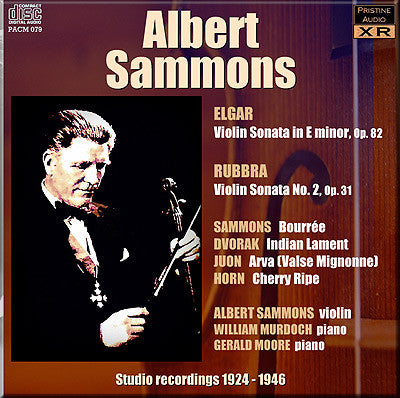
This album is included in the following sets:
This set contains the following albums:
- Producer's Note
- Full Track Listing
- Cover Art
British music specialist Sammons in Elgar and Rubbra sonatas
Newly transferred and XR remastered, these are superb!
The two sonatas here were transferred from near-mint 78s from the
collection of Paul Steinson, to whom we are once more very grateful.
Neither presented any major difficulties in transfer or restoration, and
both have come out remarkably well - in their post XR-remastering
states there's remarkably little difference in sound quality between the
1935 Elgar and the 1946 Rubbra beyond slightly raised a degree of
surface noise in parts of the earlier recording.
The Gramophone's review of the Elgar complains of a distance in the
piano which I suspect might be due to microphone positioning relative to
the piano's soundboard - the balance isn't too bad but the piano has a
muffled tone to it which suggests the lid being partially closed or
pointed away from the microphone, whereas Sammons is close and clear.
The 1920s recordings display similar traits, suggesting a tendency for
the engineers to concentrate overwhelmingly on capturing the violin -
notably on none of these is the pianist credited. One should also
remember that the engineers who recorded the final two pieces here, both
acoustic recordings where recording violins required the use of
modified instruments to boost their volume, may well have been the same
who worked on the earlier electrical recordings - with similar
priorities subconsciously in mind perhaps?
Andrew Rose
Albert Sammons, violin
William Murdoch, piano
Recorded 2 February 1935
Issued as Columbia LX 379-381
Matrix Nos CAX 4721--26
Takes 2, 1, 1, 1, 1, 2
- RUBBRA Violin Sonata No. 2, Op. 31
Albert Sammons, violin
Gerald Moore, piano
Recorded 16 April 1946
Issued as HMV C.3547-48
Matrix Nos 2EA 10975-78
All second takes
- SAMMONS Bourrée
- DVORAK (arr. Kreisler) - Indian Lament*
- JUON - Arva (Valse Mignonne)
- HORN (arr. Cyril Scott) - Cherry Ripe
Albert Sammons, violin
*Gerald Moore, piano
(other pianists unknown)
Sammons Bourrée
Recorded 9 September 1926
Matrix No WAX 1889
Dvorák Indian Lament
Recorded 2 March 1928
Matrix No WAX 3337
Issued together as Columbia 9484
Juon Arva & Horn Cherry Ripe
Recorded acoustically c. late 1924
Matrix Nos A 1249-50
Issued together as Columbia D.1509
Gramophone Historic Review
Elgar - Violin Sonata
There seems to be a general opinion that Elgar is not at his best in his chamber music and that he writes with no real understanding of the piano. One critic says that the chamber music works measured as they must be (italics mine) with the composer's own best work are a little disappointing.
But why must such works be measured against those
of big scale? Surely it is better to assess them on their own ground
realising that, as Mr. Maine well says, that "the conditions of the
sonata and quartet call forth a wholly different aspect of his (Elgar's)
creative spirit " without any resultant cramping of his style, for he
did not attempt to express symphonic ideas through the chamber music
medium.
The Elgarian trochaic rhythm appears before the music has
gone very far, also the Elgarian tenderness and nobility. I must confess
to finding the episode consisting of widely spread arpeggios for the
violin a little dull and quite lacking in the "poetic serenity which may
well have been induced by the woodland environment of the cottage where
the work was written." The end of the movement, too, is conventional
and manufactured.
No qualifications need be made in regard to the slow movement, which is both original in layout and beautiful.
This Romance is worked out with two well-contrasted ideas, one sad and deeply expressive, the other whimsical and wayward. It is indeed a pity that the passionate climax to which the music is rising is broken off by the necessity of turning over the record. The opening theme of the final movement, with an attractive waviness in it, is of a peaceful nature, a feeling which is maintained throughout most of the movement, though towards the end of this side a deeper emotion disturbs the music and the development is occasionally vigorous. Albert Sammons' tone is as unfailingly beautiful as his technique is superb, but it is, I feel, a thought too sweet for a perfect interpretation of the music, which demands a more masculine impulse at times. Though Elgar's writing for the piano is certainly not adventurous (which makes the pianist's part in this sonata very suitable for the average amateur), William Murdoch remains rather too much in the background and the balance is therefore uneven. Nevertheless this recording is certainly one to give great pleasure.
A.R. - The Gramophone, August 1935 (review of original Elgar 78s issue)

